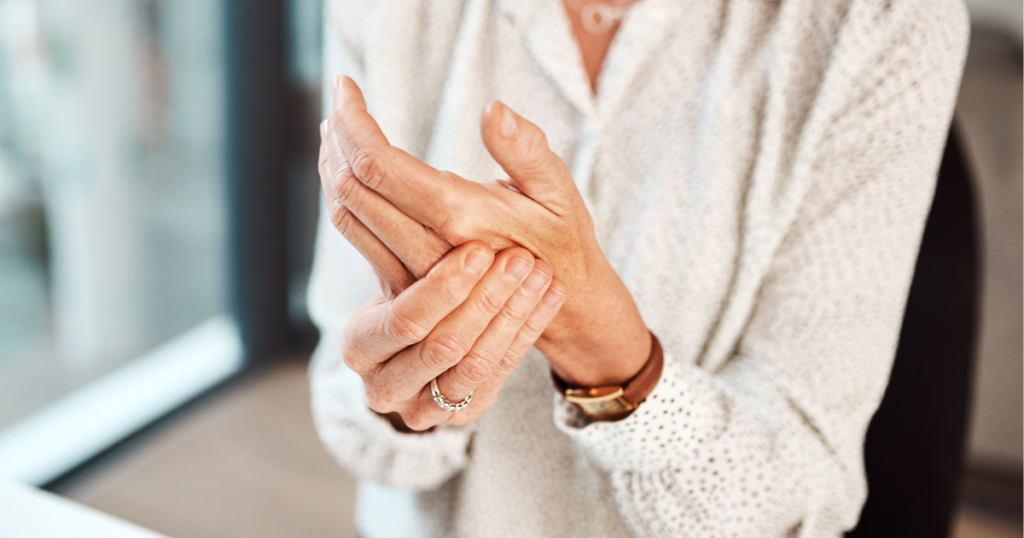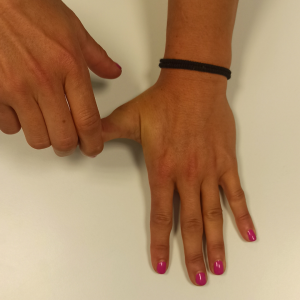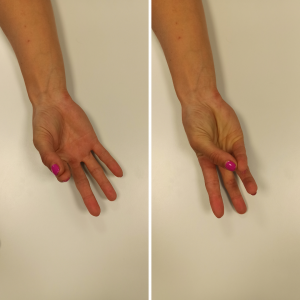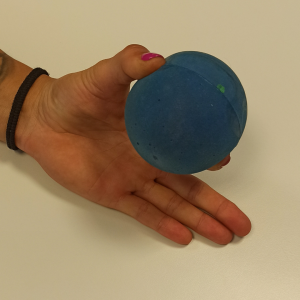Rizoarthrosis and Nodal arthrosis: differences, symptoms and cures

After a day at work, many of us, particularly those who perform repetitive manual jobs or use a mouse and keyboard for many hours a day, will have felt pain or tenderness in the hand, especially at the base of the thumb. The pain in the hand becomes acute when closing the hand to grip an object or when exerting light pressure, even just to open the door using a key. This could be the onset of Rizoarthrosis, a form of arthrosis affecting the hand, or more specifically, the thumb.
Arthrosis of the hand is one of the most common degenerative conditions of the skeletal system, along with arthrosis of the hip and the knee, which we have already discussed in this article devoted to the differences between osteoarthrosis and arthritis.
With the help of our physiotherapists, today we will learn how to differentiate Rizoarthrosis from Nodal Arthrosis of the hand, which are the first symptoms, cures and, finally, which physiotherapy exercises can help us to maintain joint flexibility and reduce thumb pain.
Rizoarthrosis: what is it, and what is the difference to Nodal Arthrosis of the hand
Rizoarthrosis is an arthropathy of the trapeziometacarpal joint. It has a very precise location, at the base of the thumb, at the first carpometacarpal joint, and the specific symptoms are pain and stiffness in this area.
Right from the first symptoms, this helps us to identify a difference compared to Nodal Arthrosis of the hand, an advanced arthritic condition which particularly affects the distal interphalangeal joints (between the second and third phalanx) and the proximal joints (between the first and second phalanx), but only in some cases also in the trapeziometacarpal area.
Nodal Arthrosis is very painful, particularly in the morning, and is characterised by tumefaction and characteristic nodules, while these symptoms do not appear with Rizoarthrosis. These swellings are known as Heberden nodules or Bouchard nodules, depending on whether they appear between the distal or proximal interphalangeal joints.
Rizoarthrosis and Nodal Arthrosis: the symptoms
The inflammatory process arising from the deterioration of the cartilage covering the joints, which leads to the development of arthrosis, generally begins at around 50 years of age, reaching a peak of occurrence after 65 years in 60% of men and 70% of women. Osteoarthritis rarely affects people aged below 40, and Rizoarthrosis and Nodal Arthrosis are no exception.
With Rizoarthrosis, the initial symptoms are:
- Pain, tenderness and stiffness at the base of the thumb: this particularly occurs when gripping something between the thumb and index finger, or when exerting light force, such as turning a key in a lock or a door handle.
- Reduced strength and range of movement: even simple everyday gestures, like opening a jar or doing up a button can become difficult.
- Swelling or the presence of a slight protuberance: the joint may swell due to an inflammation, and in some cases appears more square and wide than normal.
On the other hand, the first signs of Nodal Arthrosis are very similar to those of Rizoarthrosis. The main difference is that the pain and stiffness are felt above all in the last phalanxes of the fingers, which, as we said, in advanced phases can become deformed due to the formation of nodules.
Cure and treatment of Rizoarthrosis
Rizoarthrosis is diagnosed by the doctor based on the patient’s clinical history, a physical examination and an x-ray of the hand. Before understanding which treatment to adopt, it is important to establish a differential diagnosis with other pathologies with very similar symptoms, such as De Quervain’s tenosynovitis, tenosynovitis of the Flexor Carpi Radialis or a fractured Scaphoid.
Conservative treatment is obviously the first option for cases of Rizoarthrosis, and this starts specifically from a change in habits, to avoid repetitive and stressful movements of the trapeziometacarpal joint.
The physiotherapy programme must be established on the basis of:
- Mobility exercises and thumb stretching.
- Strengthening of the intrinsic muscles (located only in the hand) and extrinsic muscles (located in the forearm and hand).
- Instrumental therapy such as LASER or TECAR.
- Use of hand splints: the ideal solution is a specific splint for Rizoarthrosis, made to measure by a physiotherapist specialised in hand rehabilitation.
If conservative treatment fails, or the arthrosis is too far advanced, surgery may be an option. Rizoarthrosis surgery includes a wide range of options depending on the level of joint degeneration and the patient’s needs.
Classic surgery is a trapeziectomy and suspension arthroplasty to remove the trapezium, followed by immobilisation for three weeks and a subsequent period of physiotherapy, with an average progressive recovery time of around three months.
In recent years, interventions have begun to insert very small interposition prosthesis or joint prosthesis to replace the joint heads.
The Physiotherapist’s advice: useful exercises for Rizoarthrosis
If the cartilage inflammation and deterioration is not too advanced, we recommend a series of simple exercises for Rizoarthrosis that can be done autonomously every day and which may be useful for improving hand mobility and reducing pain.
 |
Thumb stretching Grip the painful thumb with the other hand and delicately pull it away from the palm of the hand, stretching it outwards. Hold the position, if not painful, for 30 seconds and repeat 3 times. |
 |
Finger opposition Bring the thumb and index finger close together, touching the fingertips. Open the hand and bring the thumb and middle finger close together. Repeat with all the other fingers. Repeat twice, completely forward and backward. Repeat 3 times. |
 |
Thumb abduction Place the palm of the hand on the table, with all fingers touching the surface. Raise the thumb upwards, keeping all the other fingers on the table. Keep the thumb raised for 5 seconds then lower it. Repeat 10 times. |
 |
Thumb muscle stabilization Grip a small soft ball between the thumb and index finger. Tighten the grip on the ball between the fingers, contracting for 5 seconds. Repeat 10 times. |



